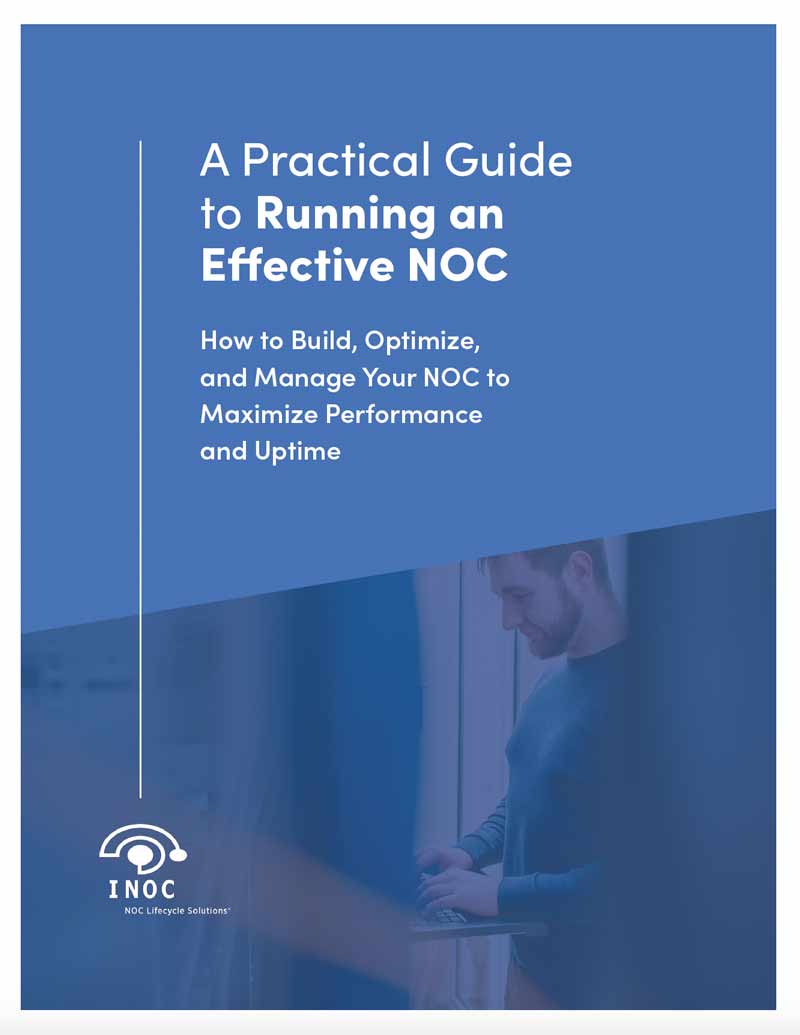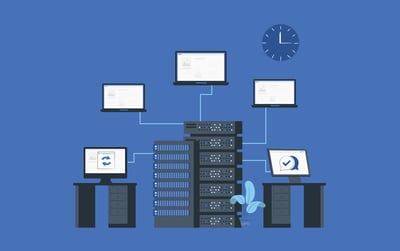In case your time is short
Here are the ten best practices for operating a successful NOC we cover in this guide:
-
Implement a Tiered Organization/Workflow: Organize NOC activities and workflows based on specific technologies and skill levels to handle events, service requests, and incidents efficiently, aiming to resolve a significant portion of incidents at the Tier 1 level.
-
Track Meaningful Operational Metrics: Focus on meaningful metrics that reflect the size, scale, and performance against organizational objectives. Key Performance Indicators (KPIs) such as first-call resolution and mean time to restore are essential for continuous improvement.
-
Develop a Strategy for Hiring, Training, and Retaining Top Talent: Staff your NOC adequately for 24/7 operations, taking into account the required skill levels, benefits plan, training needs, and attrition rates to ensure a high retention rate and adequate staffing.
-
Implement a Standardized Framework for Process Management: Adopt standardized process frameworks like ITIL to ensure consistency in handling support situations, starting with areas of biggest challenge such as incident management and problem management.
-
Develop and Maintain a Business Continuity Plan (BCP): Create a comprehensive BCP to manage risk and ensure quick and effective recovery from disasters, minimizing the negative impact on the business.
-
Develop an Effective Customer Experience Management Program: Continuously monitor service quality and assure adherence to agreed-upon processes and procedures to maintain high levels of customer satisfaction.
-
Develop Platform Integrations and Consolidate Data for Action: Integrate various tools and platforms into a "single pane of glass" for efficient monitoring, troubleshooting, and incident resolution.
-
Support Each NOC Function with Proper Documentation: Ensure thorough documentation of workflows, processes, and performance metrics to facilitate consistent problem-solving, training, and knowledge sharing.
-
Design Your NOC Operation for Scalability: Plan for predictable growth in customer base, network complexity, and service offerings, ensuring the NOC can scale without compromising service quality.
-
Budget Your NOC Operation Appropriately: Allocate resources adequately across staffing, training, quality assurance, systems, software licensing, infrastructure, and compliance to support a 24x7 operation effectively and efficiently.
Need guidance or support implementing any of these practices? Contact us to schedule a solutions session. We'd love to talk NOC.
Here's a quick look at our service delivery platform — INOC Ops 3.0 — that keeps enterprises, service providers, and OEMs up and running 24x7. Read our platform explainer for a deeper dive.
Table of contents
Despite being critical to the success of a technical support operation, many network operations centers (NOCs) fail to meet desired service levels.
Ineffective NOCs consume management and financial resources rather than delivering meaningful ROI by maximizing infrastructure uptime and performance, leaving business services vulnerable.
Most of the time, the root cause of an underperforming NOC is a lack of a centralized support framework that incorporates best practices and implements them. Such a structure is essential to the success of a NOC, as it makes decisions and actions consistent across the people, processes, and platforms that comprise it.
Without an authoritative operating blueprint, costly inefficiencies are inevitable and serious risks will continue to threaten performance and availability. This problem will only worsen as business services and the technologies they rely on scale in size and complexity.
Here, we explore ten NOC best practices for keeping even the largest, most complex infrastructure environments up and running at peak performance 24/7.
📄 Download our white paper, "Top 10 Challenges to Running a Successful NOC," for a handy reference that discusses each of these best practices and their corresponding challenges in greater depth.
📄 Read our other white paper, "A Practical Guide to Running an Effective NOC," for a set of actionable steps you can take to put these best practices to use.
Need help putting these best practices into action? Let's talk NOC. Schedule a free NOC consultation and connect with our Solutions Engineers about improving your current support operation or getting exactly the level of third-party support you need.
1. Implement a Tiered Organization/Workflow
One of the biggest obstacles to success is organizing your NOC activities and workflows according to your specific technologies and skill levels.
Once you’ve cleared this hurdle, however, you’ll almost certainly be able to handle events and service requests and resolve incidents at the appropriate tier, and faster than before. Based on data collected across our NOCs, we found this structure can enable a NOC to resolve 65% to 75% of incidents at the Tier 1 level while reserving Tier 2 and 3 staff for more advanced issues.
Classifying NOC activities is often the first step in implementing a tiered structure. Use the following model for developing your own classification system:
- Monitoring events from technology infrastructure and facilities — e.g., Layer 1, 2, and 3 networks, circuits and servers (physical, virtual, and cloud), applications, databases, and power and building systems
- Managing support requests from customers and technical staff in the form of phone calls, emails, and tickets
- Managing incidents resulting from events and support requests
- Managing configurations and changes, provisioning equipment, services, and circuits, and maintaining documentation
- Reviewing periodic service reports
Figure 1 below illustrates a well-organized tiered NOC support structure in action. Here, the Tier 1 team uses monitoring tools and interacts with end-user help desks, as well as Tier 2 and 3 engineers and third parties. Information flows between the various entities within a well-defined process framework.%20rev2-1.png?width=707&name=INOC.COM%20%20NOC%20Best%20Practices_%2010%20Ways%20to%20Improve%20Your%20Operation%20in%202020%20(1)%20rev2-1.png)
Having such a structure for properly managing your workflow can prevent your NOC from being overwhelmed by the “wall of red” NOC teams strive to avoid at all costs. In most NOCs, issues should be prioritized and organized into a set of queues, so the appropriate group can handle each of them.
Download our white paper, "Top 10 Challenges to Running a Successful NOC," for a set of example workflow queues you can use to break up issues and assign them to groups based on skillset.
This best practice addresses the following problem indicators. Talk to us to explore a NOC solution if you're experiencing any of them:
- Frequent miscommunication and confusion among team members
- Inefficient incident response times and resolution
- Inability to effectively manage and prioritize incidents
- Poor knowledge sharing and collaboration within the team
- High stress levels and burnout among NOC staff
2. Track Meaningful Operational Metrics
Modern NOC tools make it easy to generate metrics, but tracking meaningful metrics takes diligent work. Metrics are essential for continuous improvement from both a technical and motivational standpoint—helping teams recognize successes and keep morale high.
Anyone who works in a NOC likely hears things like, “We’re always busy,” or “I feel like we can never catch up,” or “My coworkers are not pulling their weight.” These sentiments are understandable given the fast-paced environment of a NOC and the constant multitasking that is required of those who work in it.
To ensure accomplishments are recognized, it’s important to set performance objectives and evaluate them on a daily, weekly, and monthly basis. Since the amount of data available to a NOC is daunting, choose the most applicable and actionable metrics to your specific operation. These should reflect the size and scale of your operation and the key performance indicators (KPIs) that measure performance against relevant organization objectives.
KPIs to consider include first-call resolution, percentage of abandoned calls, mean time to restore, and the number of tickets and calls handled.
Aside from KPIs, there's another category of metrics that is often a complete blindspot for many NOCs: utilization metrics.
These metrics reveal when and why the NOC is or isn't busy—and what it's busy with—so staffing levels can be fine-tuned for peak efficiency.
Read our post for a deep dive on these metrics: NOC Performance Metrics: How to Measure and Optimize Your Operation
This best practice addresses the following problem indicators. Talk to us to explore a NOC solution if you're experiencing any of them:
- Difficulty in measuring and tracking NOC performance
- Inability to identify areas of improvement or inefficiencies
- Failure to correlate metrics with business outcomes
- Lack of clarity on the effectiveness of implemented changes
- Difficulty in setting and meeting performance targets
3. Develop a Strategy for Hiring, Training, and Retaining Top Talent
Running a 24x7 NOC requires staffing three shifts a day, 365 days a year. Consider the following factors when developing a staffing strategy:
NOC Organization Structure
Effectively staffing a 24x7 NOC starts with a well-organized structure. The tiered NOC support structure and workflow queues discussed in our first best practice are good starting points for determining the skill level required of your NOC staff.
Download our white paper, "Top 10 Challenges to Running a Successful NOC," for an example of a skills-based NOC structure that can support 24x7 NOC requirements and provide a growth plan to maximize employee retention.
Utilization Metrics
Consider the overall activity of your NOC, including the volume of calls, emails, and alarms handled by hour of day, day of week, and type of support engineer, as well as the duration of incidents.
Benefits Plan
Consider the benefits that your company provides for employees in the context of the needs of your operation to ensure understaffing isn’t a risk. For example, if your company provides 10 holidays and four weeks of PTO per employee, these hours need to be accounted for to ensure that your NOC runs smoothly.
Training
A NOC training program should cover initial onboarding as well as ongoing training. A truly comprehensive training program can take up to six months of various classes and on-the-job instruction before an engineer is ready to take on NOC support responsibilities. After work has begun, monthly or quarterly training sessions should be scheduled to keep engineers’ skills fresh and to update the support team on new types of services, new customer requirements, and new equipment.
Retention
Based on your historical data and industry standards, a certain attrition rate within the NOC should be taken into account. Factors that affect retention rates include company culture and NOC organization (i.e., whether there’s a clear path for employee growth from one level to the next or to other departments within the organization).
By making these calculations, you can better plan for staffing and training needs. For example, assuming that a typical engineer works five years in your NOC (a retention rate of 80%), you’d need to hire an additional 20% of staff each year.
Read our post for a deeper discussion on staffing a NOC: Staffing a 24x7 NOC: Costs, Challenges, and Key Considerations
This best practice addresses the following problem indicators. Talk to us to explore a NOC solution if you're experiencing any of them:
- High staff turnover rates
- Prolonged vacancies for skilled NOC professionals
- Inadequate training resources and knowledge transfer
- Low employee morale and job satisfaction
- Inability to keep up with industry advancements and best practices
4. Implement a Standardized Framework for Process Management
Inconsistency is one of the main reasons NOCs don’t perform at optimal levels. Being reliably consistent requires a standardized process framework that arms your NOC with specific procedures for handling various support situations.
There are several process and management frameworks to choose from, including MOF, FCAPS, and ITIL. The ITIL* (IT infrastructure library) service framework, in particular, has become immensely popular as it’s useful in achieving the ISO 20000 certification and provides its own set of best practices to follow when delivering technology support services. It also offers the flexibility to include your organization’s custom procedures under its umbrella of lifecycle stages.
Process frameworks can be overwhelming when considered in their entirety. When aligning with one of these standards, we recommend first tackling the specific areas that are your organization's biggest challenge. Typically, these are incident management, problem management, and the service desk. Once these functions are standardized, you can move on to other priority areas, such as change management and service continuity management.
It’s critical to get your whole organization involved in implementing the process framework and in ongoing education. Training is essential to get all staff talking the same language and following the same guidelines. Comprehensive information and training are available for ITIL, ISO 20000, FCAPS, and other methodologies.
This best practice addresses the following problem indicators. Talk to us to explore a NOC solution if you're experiencing any of them:
- Inconsistencies in processes and procedures
- Difficulty in onboarding and training new staff
- Increased likelihood of human error and miscommunication
- Poor overall network performance and stability
- Inability to effectively measure and improve processes
5. Develop and Maintain a Business Continuity Plan
A business continuity plan (BCP) is essential for managing risk in your NOC operations—a fact made very clear by the COVID-19 pandemic, which exposed serious shortcomings in many firms’ readiness.
(Download our white paper, "A 5-Step Strategy for NOC Business Continuity Planning in Response to COVID-19," for a comprehensive guide to ensuring your BCP is prepared for such a disruption.)
The BCP provides a blueprint for NOC staff and management to follow when recovering from a disaster or other adverse situation. When properly executed, it ensures that operations recover quickly and effectively so any negative impact on the business is minimized.
Without an effective BCP in place, your NOC will almost certainly remain vulnerable to the following problems if a disaster or significant workforce disruption affects your operation:
- Loss of business
- Damage to reputation/brand
- Loss of customers
- Loss of staff
- Loss of or damage to property and premises
- Negative impact on insurance
Key representatives from a cross-section of the organization need to be involved in creating a BCP. This may include outside vendors. Whether you’re developing one from scratch or want to evaluate an existing BCP, make sure it contains the following at the bare minimum:
- An analysis of all organizational threats
- A list of action items required to maintain operations, both for short-term and long-term interruptions
- Easily accessible contact information for key stakeholders
- An explanation of where/how personnel should relocate if there is an interruption in operations
- The steps required to make the backup site(s) operational
- How all the areas within the organization need to collaborate in executing the plan
This best practice addresses the following problem indicators. Talk to us to explore a NOC solution if you're experiencing any of them:
- Known or "known unknown" vulnerabilities to natural disasters, cyberattacks, and other disruptions
- Inadequate backup and redundancy measures in place
- Unplanned downtime and service disruptions
- Potential loss of revenue and customer trust
- Lack of preparedness for unexpected events
6. Develop an Effective Customer Experience Management Program
NOC teams must measure service quality and provide quality assurance continuously or risk damaging customer satisfaction and compromising the NOC’s reputation. Effectively and consistently executing a runbook (i.e., processes and procedures) is paramount to meeting a NOC’s service level requirements.
The detailed monitoring of key network and IT assets and services is core to meeting these objectives. This monitoring, data collection, and correlation—typically accomplished using a variety of protocols and tools—is the entry point into incident handling and problem management processes.
Other sources of data include calls and emails (among still others). The NOC runbook, created during onboarding and updated regularly, is key to what follows next. Documenting agreed-upon processes and procedures for the specific customer environment provides the NOC team with an essential operational reference.
NOC Quality Control
A good quality control program monitors and measures primary aspects of your NOC service via its KPIs. These KPIs provide much-needed visibility into NOC support activity, responsiveness, and effectiveness. NOC management can use this information to ensure, for instance, that stated objectives for event-to-action times and first-level incident resolution are being met for each customer.
Quality control also detects chronic issues so management can find appropriate solutions—for example, correcting relevant runbook procedures, ensuring complete documentation is available to the NOC, or providing additional staff training. A monthly audit of a subset—say, 10%—of all tickets created is an important part of an ongoing review. Staff mentoring is also key to quality control and helps ensure high levels of customer satisfaction.
NOC Quality Assurance
A quality or service assurance program enables your NOC to identify and resolve problems before they significantly impact customers or the business.
A quality assurance review begins when a customer reports dissatisfaction with any aspect of the NOC service. NOC management follows up with an internal review of the service, evaluating responsiveness metrics, adherence to runbook procedures, customer interaction, and technical troubleshooting, to name a few.
Such quantitative and qualitative measures and the resulting feedback lower the chance of the same problem recurring. Monthly and quarterly reviews of the service with stakeholders ensure that customer expectations remain met.
This best practice addresses the following problem indicators. Talk to us to explore a NOC solution if you're experiencing any of them:
- Inconsistent service levels and customer experience
- Inability to identify root causes and implement corrective actions
- Lack of a culture of continuous improvement
7. Develop Platform Integrations and Consolidate Data for Action
NOCs operating at peak efficiency can receive and process alarm or event information from multiple sources and present it in a consolidated view for staff to act on. This consolidated view is commonly called a “single pane of glass.”
Most NOCs need to bring voice, email, text, customer portals, knowledge bases, documentation, and workflow management tools into the NOC—each potentially with its own platform. Without proper integrations connecting these tools and platforms, NOC personnel are faced with tracking and managing multiple screens for event information, manually collecting information from multiple sources for documentation, notification, and escalation, and then attempting to manage workflow toward service restoration.
This makes monitoring and reporting on SLA metrics nearly impossible, let alone optimizing performance. The results inevitably include operational inefficiencies, missed SLAs, and undue stress on staff.
Download our white paper, "Top 10 Challenges to Running a Successful NOC," to see the various tools that are required for a NOC to function and that should be integrated into a single NOC platform.
This best practice addresses the following problem indicators. Talk to us to explore a NOC solution if you're experiencing any of them:
- Inefficient troubleshooting and incident resolution
- Difficulty in monitoring and managing the entire network infrastructure
- Increased likelihood of human error and miscommunication
- Challenges in sharing and accessing relevant information among team members
- Inability to provide a unified view of the network for decision-making
8. Support Each NOC Function with Proper Documentation
Documentation is essential to a NOC’s ability to function well over the long term. This process includes building runbooks, documenting workflow processes, creating structured databases for storing and retrieving information, and recording business results for analysis and optimization.
Too often, however, services are added, or changes are made without proper documentation to support them. This limits the ability of the NOC to resolve an issue when it arises—wasting time and creating avoidable risks.
Poor documentation often stems from a lack of resources and the expertise required to map out processes and create work instructions and documents. Instead, key people simply “know what to do” and new staff learns by “seeing and doing” alongside an experienced mentor.
NOC teams also often overlook performance metrics that can be obtained from network and monitoring systems, ticketing systems, and back-office tools. These metrics are critical for analyzing performance, predicting failure, and laying the groundwork for ongoing quality control and process improvement.
Without an understanding of alarm activity, ticket activity, and common causes for outages and trends, management is limited to responses that are reactive and tactical, rather than proactive and strategic.
Beginning with the service catalog, it is necessary to document the tools and procedures needed to deliver NOC services successfully. Technical writers can often be invaluable in this process.
This best practice addresses the following problem indicators. Talk to us to explore a NOC solution if you're experiencing any of them:
- Inconsistent problem-solving approaches among team members
- Difficulty in training and onboarding new staff
- Prolonged incident resolution times
- Increased likelihood of recurring issues
- Inability to retain and share knowledge within the team
9. Design Your NOC Operation for Scalability
A NOC’s scalability is a measure of its ability to handle a growing amount of work without compromising the level of service. Typically, business plans include initial funding, sales and marketing, system build-out, operations support, and the business guidance needed to meet the projected growth. What business plans sometimes don’t consider is predictable growth and process planning.
Often, for example, sales for a young company take off, with key managers focused on new clients and getting technical services delivered to meet service launch dates. The same technical and operations resources are then tasked with the ongoing support of these services—severely impeding the organization’s ability to manage its growth. The result is predictable: customer dissatisfaction.
The ability to grow or absorb expansion requires careful consideration of the following factors:
- Staffing: It is essential to measure the staff utilization percentage derived from various NOC activities (described in our second best practice). Keeping this below 80% enables your NOC to absorb growth while allowing enough lead time for recruiting additional resources.
- Systems and Network: A distributed redundant architecture allows for systems to grow and expand. The ability to easily deploy additional server resources enables you to handle sudden spikes in growth. The performance of the systems and network (bandwidth, CPU, memory, etc.) needs to be monitored closely to make sure there is enough capacity to handle growth.
- Tools: Tools used by the NOC (e.g., monitoring tools, ticketing systems, knowledge base) to deliver the service must have additional capacity built into them to handle the projected growth. It’s not uncommon for tool performance to suffer dramatically if tools aren’t designed for growth resulting in service-level degradation and a loss in productivity.
- Process Standardization and Training: A consistent process framework and methodology for delivering high-quality service is one of the key features of a scalable NOC. Management should choose and adopt a process standard that fits their product and industry needs. NOC staff can then be trained to follow the established company standards.
This best practice addresses the following problem indicators. Talk to us to explore a NOC solution if you're experiencing any of them:
- Frequent network bottlenecks and performance issues
- Inability to meet the demands of expanding customer base or service offerings
- Difficulty in adapting to new technologies or industry trends
- Inadequate resources to manage growth in network complexity
- Negative impact on customer satisfaction and business reputation
10. Budget Your NOC Operation Appropriately
There are several components that make up the cost of running a 24x7 NOC. When budgeted appropriately, these items combine into a powerful investment that has the potential to deliver a value that far exceeds its cost.
- Staff: The staff required to support a 24x7 NOC include not only front-line engineers, but also back-end support groups such as systems and network engineering, service transition, human resources, and customer advocacy.
- Training: Resources need to be allocated for training NOC staff when they are initially hired, when onboarding new customers, and whenever changes are made to existing support or new technologies are introduced.
- Quality Assurance: An objective quality assurance program is needed to address customer concerns and maintain service-level agreements.
- Systems, Networking, and Security: Systems, network connectivity, and security controls need to be deployed in either data centers or the cloud to house the various tools and applications required by the NOC to operate. Resources for ongoing support need to be included.
- Software Licensing: A NOC requires various tools for monitoring, troubleshooting, and resolving issues. These include network and element management systems (NMS/EMS), trouble ticketing systems, knowledge bases, portals, and configuration management databases (CMDBs).
- Infrastructure and Facilities: A NOC must be designed and maintained to enable smooth workflow and communication among staff. Redundancy and business continuity are essential to mitigate risk.
- Compliance: NOC services must comply with various regulatory and industry-standard requirements.
All of these components present a formidable operating expense but have to be considered in building a successful NOC. Too often, NOCs are built considering only a subset of the above components, and as a result, they struggle to scale and deliver on the required service and financial objectives of the organization.
This best practice addresses the following problem indicators. Talk to us to explore a NOC solution if you're experiencing any of them:
- Increasing expenses without corresponding improvements in network performance or service quality
- Inefficient use of resources, including staff and tools
- Difficulty in allocating funds for network improvements or growth initiatives
- Reduced competitiveness in the market due to high costs
- Inability to meet financial targets or maintain profitability
11. Implement machine learning and automation (AIOps) to radically improve efficiencies and performance while reducing human labor
For years, top-tier NOCs have started applying automation to repetitive, low-risk tasks that distract technical specialists from more important (and frankly more exciting) work. Only more recently, however, have NOCs started arming themselves with vastly better data processing and machine learning power to augment and replace more complex manual tasks traditionally handled by humans.
Perhaps the most impactful recent advancement is AI-driven event correlation. NOCs can now let machines correlate event data much faster than humans ever could and identify the subtle indicators of approaching issues within a torrent of otherwise noisy data. The outcome can be measured in significantly faster and more proactive response rates—and thus, happier customers and end-users.
Here are the major ways we've implemented AIOps within our NOC to unlock dramatically better efficiency and performance:
- Event Monitoring and Management: AIOps can aggregate data from multiple data sources and multiple technology areas across the entire enterprise and provide a central data collection point. It can then analyze this data quickly and accurately to determine when multiple signals across multiple areas indicate a single issue. The resulting reduction in alert noise brings into focus those alerts that require action and helps reduce Time to Impact Analysis and thus reduce Mean Time to Repair. Events can also be correlated with past configuration changes, allowing for faster, more reliable root cause determination.
- Incident Management: AIOps can feed analysis into the Incident Management process by autonomously surfacing the probable cause and allowing the NOC engineer to confirm that the analysis and data are sound before implementing a resolution plan. The result? Faster incident analysis. AIOps can also automate responses and substantially reduce reduction times when implemented cautiously and thoughtfully. Once a root cause is determined with high confidence, a solution can be automatically implemented if it’s available. Low-risk automation for routine alerts in non-business-critical workloads is a smart starting point, freeing NOC engineers to focus on complex infrastructure support issues. Lastly, AIOps can issue predictive alerts when it correlates real-time event and performance data with past event data that resulted in outages to identify developing problems before they require a reactive response.
- Problem Management: While the goal of Incident Management is to restore service quickly, Problem Management determines the root cause and finds a permanent solution to avoid the same incident in the future. Root cause determination is typically resource-intensive, requiring hours of event and log data analysis. With access to multiple sources and massive amounts of data, AIOps can radically improve post-event root cause analysis.AIOps can provide intelligent analysis—ranking events by their relationship to the original alert, noting anomalies, and suggesting possible causes—to streamline the Problem Management process. This capability allows the NOC engineer to more easily and confidently confirm the analysis, verify the data behind it, and then develop a solution.
- Change Management: Maintenance events are common in the NOC. An effective AIOps implementation allows automatic suppression of alarms when an infrastructure or application maintenance event is recorded. Automation will then only create tickets if appropriate after a maintenance window has been completed. Alarms can be associated with the change by tying in the configuration item; this helps correlate future events with configuration changes. AIOps can also provide for deeper impact analysis by using relationship and topology data from multiple sources, such as the CMDB and monitoring tools, to help IT teams understand how a change on one node may propagate to other nodes, leading to a potentially undesired impact. Lastly, by applying AIOps to historical change data, IT teams can get insight into the likely consequences before implementing a change. Changes can be given risk scores (such as low, medium, or high) to help quantify acceptable risk and inform the decision to deploy a change.
This combination of automation and machine learning brings the power and promise to genuinely transform how IT operations teams organize and operate. And as time goes on, automation will steadily continue to replace even more manual activities better suited for machines.
Given the complexity of integrating machine learning and automation into a NOC operation, there are no convenient action items to point to here; such an undertaking, while transformative, requires a ton of highly-specialized work and significant investment — moreso than what what would make sense for most teams to build internally.
Here at INOC, our clients simply inherit the powerful AIOps capabilities we've spent years and many resources building and refining. The core of our alarm and event management system is our AIOps engine, which utilizes machine learning to automate low-risk tasks and extract actionable insights from the vast amounts of data gathered across clients' supported environments.
- Our AIOps tools correlate alarms from multiple sources, perform deep inspection of those alarms, and enrich them with additional metadata from our CMDB to expedite informed action. Importantly, you can seamlessly integrate your existing infrastructure monitoring system with our AIOps toolset to retain the systems you already use while further maximizing those investments.
- This integration feeds alarms from your NMSs (or ours if needed) into our platform, streamlining alarm correlation, enrichment, and automatic ticket creation. After a ticket is generated, our platform automatically identifies and attaches CIs from our CMDB, giving NOC engineers clear direction for investigation before any human intervention. The platform also supplies relevant knowledge articles and runbooks, facilitating fast, accurate diagnosis and action plan development.
Final Thoughts and Next Steps
While it’s easy to talk about best practices, it’s another thing entirely to bring those practices to life within your organization. Success requires careful planning and care, which is why expertise is so critical at the outset of building or optimizing your NOC
Here at INOC, we help organizations with these critical needs through award-winning outsourced NOC support (sometimes referred to as NOC as a Service) and NOC operations consulting services.
- NOC Support Services: Our NOCs monitor tens of thousands of infrastructure elements around the clock. High-level NOC management expertise and custom-built systems ensure you and your customers achieve the infrastructure performance and availability needed to grow and thrive no matter how your IT environment evolves or what new challenges arise. By following an operational methodology that utilizes a tiered support structure in full alignment with the ITIL framework, our NOC can rapidly respond to incidents and events and continue to implement changes as needed, all under a more cost-effective service model.
- NOC Operations Consulting: We also deliver comprehensive best practices consulting for designing and building new NOCs and helping existing NOCs significantly improve the support provided to you and your customers. Our approach to high-quality support aligns and integrates each function of NOC support operations to enable more informed, consistent decision-making in line with the ITIL framework.
Want to learn how to put these best practices to use in your NOC? Contact us or schedule a free NOC consultation with our Solutions Engineers to see how we can help you improve your IT service strategy and NOC support download our free white paper below.
*Originally developed by the UK government’s Office of Government Commerce (OGC) - now known as the Cabinet Office - and currently managed and developed by AXELOS, ITIL is a framework of best practices for delivering efficient and effective support services.

Free white paper A Practical Guide to Running an Effective NOC
Download our free white paper and learn how to build, optimize, and manage your NOC to maximize performance and uptime.
*Originally developed by the UK government’s Office of Government Commerce (OGC) - now known as the Cabinet Office - and currently managed and developed by AXELOS, ITIL is a framework of best practices for delivering efficient and effective support services.






